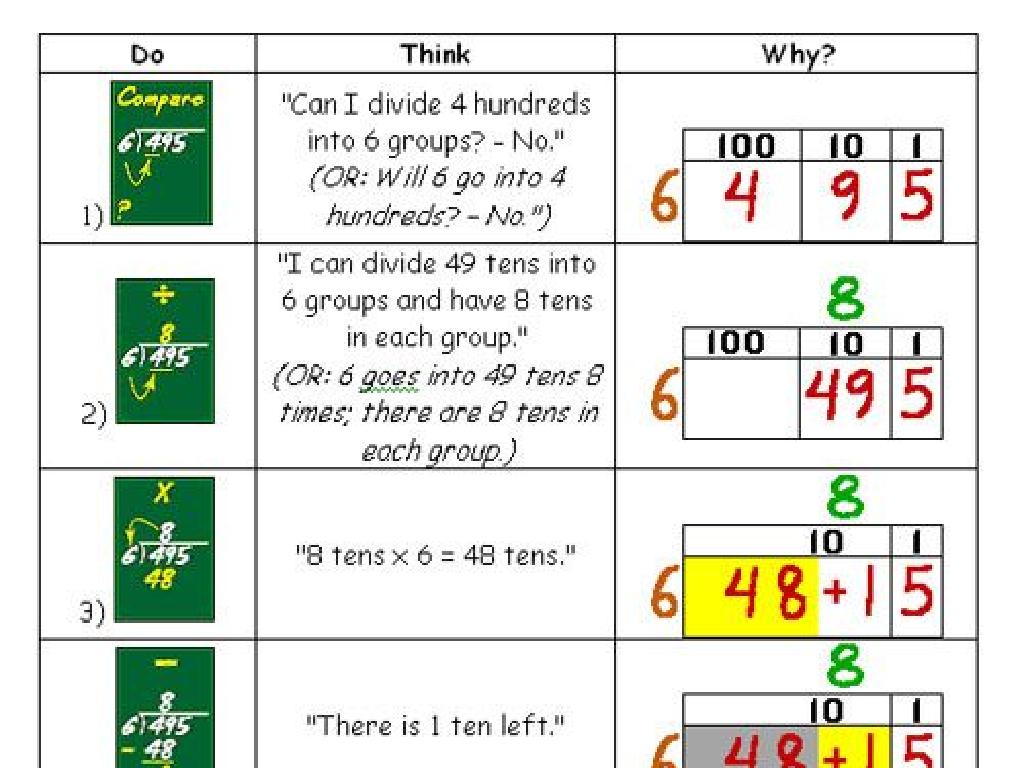Origins Of Hinduism
Subject: Social studies
Grade: Seventh grade
Topic: World Religions
Please LOG IN to download the presentation. Access is available to registered users only.
View More Content
Origins of Hinduism
– Explore world religions
– Significance of diverse beliefs
– Studying beliefs fosters respect and understanding
– Hinduism: An overview
– One of the oldest religions, with a complex system of beliefs
– Hinduism’s historical roots
– Emerged over 4,000 years ago in the Indian subcontinent
|
This slide introduces students to the study of world religions, emphasizing the importance of understanding and respecting diverse belief systems. Hinduism, as one of the oldest and most complex religions, provides a rich example of how belief systems shape cultures and histories. It originated over 4,000 years ago in the Indian subcontinent and has evolved to include a wide range of practices and deities. Encourage students to consider how religions like Hinduism have influenced social and cultural development throughout history. This introduction sets the stage for a deeper exploration of Hinduism’s beliefs, practices, and historical significance.
The Indus Valley and Hinduism
– Hinduism’s roots in the Indus Valley
– One of the world’s oldest religions, originating over 4,000 years ago.
– Harappan culture’s influence
– Harappan society contributed to Hinduism’s development with rituals and societal structures.
– Indus Valley’s role in Hinduism
– The Indus Valley was a cradle for Hinduism, influencing later religious texts and practices.
– Significance of early practices
– Early practices like ritual bathing, yoga, and meditation began in this period.
|
This slide aims to introduce students to the ancient origins of Hinduism, tracing back to the Indus Valley Civilization. Emphasize the longevity and continuity of Hinduism, making it one of the oldest living religions. Discuss the Harappan culture, highlighting its sophisticated urban planning and how its societal norms and spiritual practices contributed to what would become Hinduism. Explain the significance of the Indus Valley as a geographical and cultural hub that shaped early Hindu practices, which are still observed today. Encourage students to consider how religions develop over time and are influenced by earlier cultures and civilizations.
Vedic Age and Sacred Texts
– Introduction to the Vedas
– The Vedas are ancient scriptures, core to Hindu beliefs.
– Oral tradition and preservation
– Traditionally, these texts were passed down orally.
– Ritualistic to philosophical shift
– Over time, focus shifted from rituals to spiritual philosophy.
– Vedas’ impact on Hinduism
– This transition influenced Hindu practices and thoughts.
|
This slide introduces students to the Vedic Age, highlighting the Vedas as the foundational texts of Hinduism. Emphasize the importance of oral tradition in preserving these texts before the advent of writing. Discuss how Hinduism evolved from ritualistic practices to include a rich tradition of philosophical inquiry. This evolution marks a significant shift in the way the religion is practiced and understood. Encourage students to consider how religions adapt over time and the role of sacred texts in shaping religious and cultural identity.
Core Beliefs of Hinduism
– Understanding Dharma
– Dharma refers to duty, morality, and living righteously.
– The role of Karma
– Karma is the belief that actions and intentions lead to future consequences.
– Samsara: The cycle of rebirth
– Samsara is the repeating cycle of birth, life, death, and rebirth.
– Moksha: The ultimate goal
– Moksha represents liberation from Samsara; the soul’s release.
|
This slide introduces students to the fundamental beliefs of Hinduism, which is one of the oldest religions in the world. Dharma is a complex concept that includes duties, rights, laws, conduct, virtues and right way of living. Karma, a familiar term even in the West, is the law of cause and effect by which each individual creates their own destiny through thoughts, words, and deeds. Samsara is the repeating cycle of life, death, and reincarnation, which is viewed as a suffering cycle that souls aim to escape. Moksha is the release from this cycle and is the ultimate spiritual goal in Hinduism. Encourage students to compare these concepts with familiar ideas in their own lives or other belief systems they’ve studied.
Hindu Deities and Worship Practices
– Understanding Polytheism in Hinduism
– Hinduism has many gods, each with different roles.
– The Trinity: Brahma, Vishnu, Shiva
– Brahma the creator, Vishnu the preserver, Shiva the destroyer.
– Roles of Goddesses in Worship
– Goddesses like Lakshmi and Saraswati are revered for prosperity and knowledge.
– Significance of Multiple Deities
|
This slide aims to introduce students to the concept of polytheism in Hinduism, highlighting the significance of having multiple deities, each symbolizing various aspects of life and the universe. The Trimurti or the Trinity represents the three fundamental powers responsible for the creation, preservation, and destruction of the universe. Goddesses play vital roles, often representing strength, fertility, knowledge, and wealth, and are an integral part of Hindu worship. Understanding these deities helps students appreciate the rich tapestry of stories and beliefs that form Hindu worship practices. Encourage students to explore how these deities influence the daily lives of Hindus and the moral and philosophical lessons they impart.
Hindu Festivals and Celebrations
– Diwali: The Festival of Lights
– Marks victory of light over darkness
– Holi: The Festival of Colors
– Celebrates spring and forgiveness
– Festivals’ role in community
– Strengthen community bonds and cultural heritage
– Spiritual significance of festivals
– Enhance personal and collective spirituality
|
This slide introduces students to the vibrant festivals of Hinduism, focusing on Diwali and Holi, which are celebrated with great enthusiasm. Diwali symbolizes the triumph of good over evil and is marked by lighting lamps and fireworks. Holi heralds the arrival of spring and is characterized by the throwing of colored powders, symbolizing joy and forgiveness. These festivals are not only times for fun and celebration but also play a crucial role in reinforcing community ties and cultural identity. They offer a chance for collective joy and spiritual reflection, allowing individuals to connect with each other and with their faith. Encourage students to explore how these festivals compare to celebrations in their own cultures and the importance of such traditions in fostering a sense of belonging and community.
Hinduism Today: Global Influence & Practices
– Global spread of Hinduism
– Hinduism has followers worldwide, not just in India.
– Contemporary Hindu rituals
– Daily worship, yoga, and festivals like Diwali.
– Hinduism’s societal role
– Influences values, ethics, and social norms.
– Embracing diversity in practice
– Hinduism adapts to various cultures and communities.
|
This slide aims to shed light on the current state of Hinduism as a global religion. It’s important to highlight that while Hinduism originated in India, it has now spread across the world with a significant number of followers in many countries. Discuss how contemporary practices such as daily worship, meditation, yoga, and the celebration of festivals like Diwali are integral to Hindu life. Emphasize the role of Hinduism in shaping the moral and ethical framework of societies, influencing areas like environmentalism, non-violence, and social justice. Lastly, discuss how Hinduism respects pluralism and has been adapted into various cultural contexts, allowing for a diverse range of practices and beliefs.
Class Activity: Exploring Hinduism
– Discuss Hinduism vs other religions
– Design a poster on Hindu beliefs
– Include major gods, practices, and symbols
– Reflect on Hinduism’s intriguing aspects
– What captivated you about Hindu culture?
– Share findings with the class
– Present your poster and reflection
|
This activity is designed to engage students with Hinduism by comparing it to other world religions through group discussions. Encourage critical thinking by having them identify similarities and differences. For the creative project, students will create posters that encapsulate Hinduism’s key beliefs, major deities, practices, and symbols. This will help them visualize and better remember the concepts. Lastly, students will write a reflection paragraph to express what they found most interesting about Hinduism, encouraging personal connection to the material. Possible activities: 1) Group discussions on specific topics like festivals or rituals, 2) Individual research on a chosen aspect of Hinduism for the poster, 3) Peer review of written reflections, 4) A gallery walk to view and discuss each other’s posters, 5) A class vote on the most informative or creative poster.





